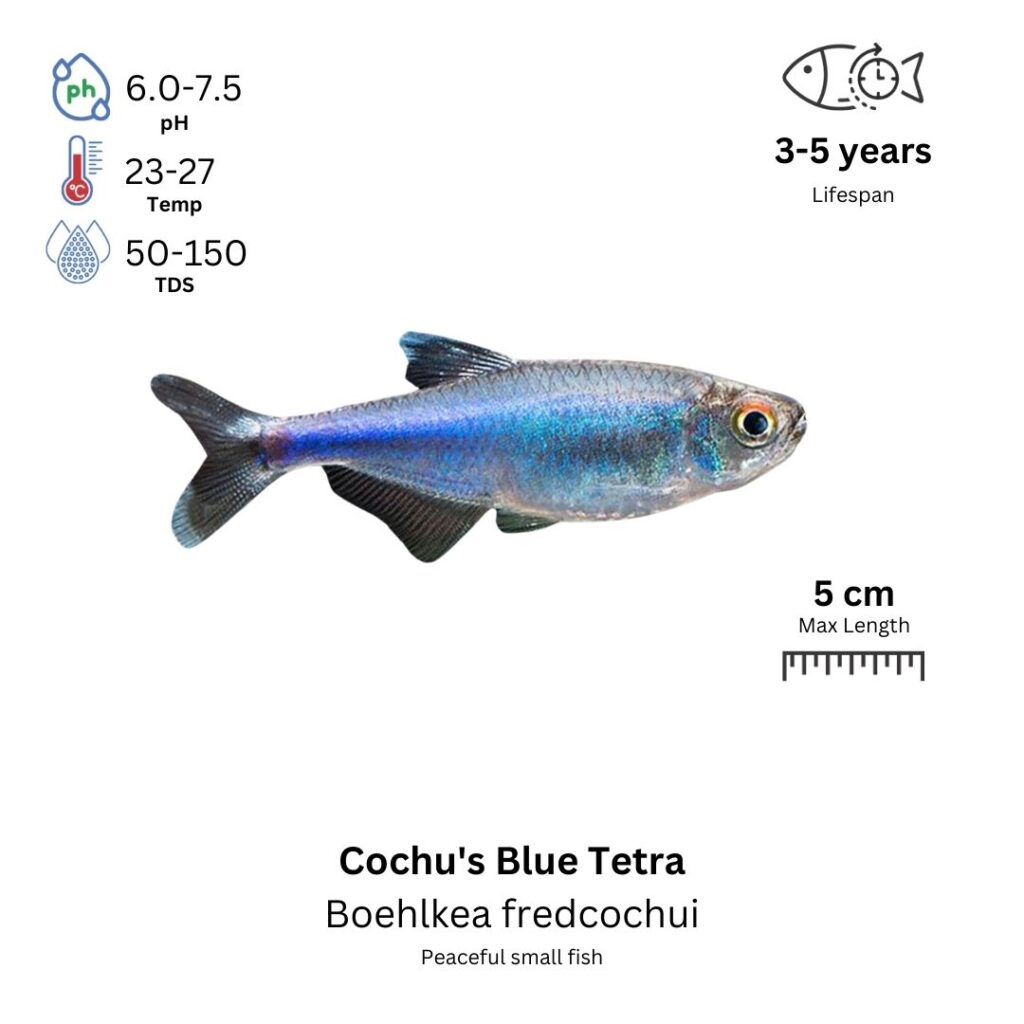Cochu's Blue Tetra
Brachyrhaphis rhabdophora

Description
Cochu’s Blue Tetra is a small, peaceful, and strikingly beautiful species of tetra known for its shimmering blue body. The male Cochu’s Blue Tetra has a vibrant, iridescent blue color that extends along the upper part of the body and is highlighted by a dark stripe running horizontally along the side. The body of this fish is slightly compressed and elongated, with a delicate, streamlined appearance. The tail and fins are translucent with subtle coloration, and the dorsal fin is slightly darkened with a hint of blue or purple. The females tend to be slightly larger and less colorful than the males. These fish are peaceful, active swimmers that prefer to be in schools, and they are ideal for community aquariums, where their shimmering bodies add beauty and movement to the tank.
Habitat Origin
Native to the slow-moving rivers and streams in Southeast Asia, specifically in parts of Thailand, Malaysia, and Indonesia. Cochu’s Blue Tetras are found in clear, slightly acidic waters with moderate flow, often inhabiting areas with plenty of submerged plants and vegetation. In their natural habitat, they tend to swim among plant cover and rocky substrates, making them a perfect fit for aquariums that mimic these conditions.
Aquarium
Ideal Number in Aquarium: At least 6 individuals, as they are schooling fish and feel more secure in groups.
Favorite Food

Cochu’s Blue Tetra is omnivorous and will accept a variety of foods. They can be fed high-quality flake food, micro pellets, and live or frozen foods such as brine shrimp, daphnia, and bloodworms. They also enjoy small plant matter and biofilm, so adding some vegetable-based foods like blanched spinach or zucchini can help supplement their diet. A varied diet will help maintain their vibrant coloration and overall health.
Behavior:
Cochu’s Blue Tetra is peaceful, active, and social, making it an excellent addition to community tanks. They thrive in schools, where they exhibit natural schooling behavior, often seen swimming in groups around the middle to upper regions of the tank. They are non-aggressive and generally calm, though they can become shy if kept alone or in small numbers. They are not fin-nippers, making them ideal tankmates for other peaceful species. Cochu’s Blue Tetras are relatively easy to care for, but their best colors and behaviors are showcased when they feel secure in groups.
Special Care:
Cochu’s Blue Tetra is a hardy fish but thrives best in stable water conditions. Regular water changes, good filtration, and monitoring pH and water temperature are important for maintaining their health. They prefer tanks with plenty of plants, as they provide both grazing areas and hiding spots. These fish are sensitive to poor water quality, so it’s essential to maintain consistent water parameters, especially when keeping them in community tanks.
Compatibility with Other Fish:
Yes, Cochu’s Blue Tetra is compatible with many peaceful fish species. They do well in a community aquarium with other small, non-aggressive fish such as rasboras, other tetras, and small catfish. They can also be housed with shrimp and snails. It is best to avoid larger or more aggressive species, as these may stress or intimidate the Cochu’s Blue Tetra. They are ideal for aquariums focused on small, peaceful fish.
Breeding Setup
Use a separate breeding tank (20-liter / 5-gallon) to manage water parameters effectively and prevent egg or fry predation. Maintain water conditions with pH 6.0–7.0, temperature 24–28°C, and GH 4–12 dGH. Use a gentle sponge or internal filter with low flow to avoid stressing the fish. Provide fine substrate like sand or smooth gravel, with live plants such as Java moss, Hornwort, or Anubias for egg attachment and fry shelter. Floating plants like duckweed create shaded, natural-like environments. Moderate lighting simulates their natural habitat with diffused sunlight.
Conditioning for Breeding
Feed a high-protein varied diet including high-quality flakes, live foods (brine shrimp, daphnia, bloodworms), and frozen foods (mysis shrimp). Perform regular 25% weekly water changes to keep water clean and stable, which promotes breeding readiness.
Spawning
Cochu’s Blue Tetras are egg scatterers. Males court females by displaying vibrant blue colors and chasing behavior. Females lay 30–100 sticky eggs on flat surfaces like tank glass, plants, or rocks. Remove adults after spawning to protect eggs from being eaten.
Fry Care
Eggs hatch within 24–48 hours depending on temperature. Fry stay near hatching surfaces while absorbing yolk sacs, then become free-swimming. Feed free-swimming fry infusoria, liquid fry food, or microscopic algae initially. After a few days, introduce baby brine shrimp or microscopic live foods. Gradually offer finely crushed flakes or small pellets as they grow. Maintain water quality with small daily water changes (10–15%) and stable temperature (24–28°C). Monitor ammonia, nitrite, and nitrate levels carefully.
Important Notes
Cochu’s Blue Tetras mature sexually at 6 to 12 months. Males are slimmer and more brightly colored, especially during courtship. Females are larger and rounder when gravid. Avoid stress by maintaining stable water parameters, providing hiding places, and avoiding overcrowding or aggressive tankmates to ensure successful breeding.
